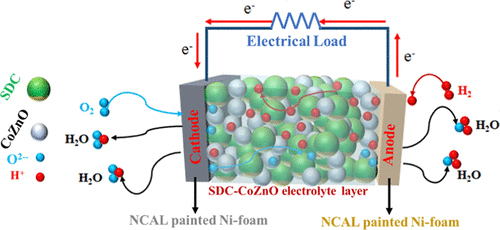当前位置:
X-MOL 学术
›
ACS Appl. Energy Mater.
›
论文详情
Our official English website, www.x-mol.net, welcomes your
feedback! (Note: you will need to create a separate account there.)
Electrochemical Properties of a Dual-Ion Semiconductor-Ionic Co0.2Zn0.8O-Sm0.20Ce0.80O2−δ Composite for a High-Performance Low-Temperature Solid Oxide Fuel Cell
ACS Applied Energy Materials ( IF 5.4 ) Pub Date : 2021-01-11 , DOI: 10.1021/acsaem.0c02095 Sajid Rauf 1 , M. A. K. Yousaf Shah 2 , Bin Zhu 3 , Zuhra Tayyab 1 , Nasir Ali 4 , Sanam Attique 5 , Chen Xia 1 , Rabia Khatoon 6 , Changping Yang 1 , Muhammad Imran Asghar 1, 7 , Peter D. Lund 7
ACS Applied Energy Materials ( IF 5.4 ) Pub Date : 2021-01-11 , DOI: 10.1021/acsaem.0c02095 Sajid Rauf 1 , M. A. K. Yousaf Shah 2 , Bin Zhu 3 , Zuhra Tayyab 1 , Nasir Ali 4 , Sanam Attique 5 , Chen Xia 1 , Rabia Khatoon 6 , Changping Yang 1 , Muhammad Imran Asghar 1, 7 , Peter D. Lund 7
Affiliation

|
Semiconductor heterostructures offer a high ionic conduction path enhanced by built-in electric field at the interface, which helps to avoid electronic conduction in low-temperature solid oxide fuel cells (LT-SOFCs). In this study, we synthesized a semiconductor heterostructure based on Co-doped ZnO and Sm0.2Ce0.8O2–δ (SDC) for LT-SOFC application. First, we optimized the composition of the Co-doped ZnO by varying the doping concentration. The cell with Co0.2Zn0.8O composition (σi = 0.158 S cm–1) yielded the best performance of 664 mW cm–2 at 550 °C. This optimized composition of Co-doped ZnO was mixed with a well-known ionic conductor Sm0.2Ce0.8O2−δ (SDC) to further improve the ionic conductivity and performance of the cell. The heterostructure formed between these two semiconductor materials improved the ionic conductivity of this composite material to 0.24 S cm–1 at 550 °C, which is 2 orders higher in magnitude than that of bulk SDC. The fuel cells fabricated with this promising semiconductor-ionic heterostructure material produced an outstanding power density of 928 mW cm–2 at 550 °C. Our further investigation shows protonic conduction (H+) in the Co0.2Zn0.8O-SDC composite, which exhibited protonic conduction 0.088 S cm–1 with a power density of 388 mW cm–2 at 550 °C. A detailed characterization of the material and the fuel cells is performed with the help of different electrochemical (electrochemical impedance spectroscopy (EIS)), spectroscopic (X-ray diffraction (XRD), UV–vis spectroscopy, X-ray photoelectron spectroscopy (XPS)), and microscopic techniques (scanning electron microscopy (SEM), high-resolution transmission electron microscopy (HR-TEM), energy-dispersive X-ray spectrometry (EDX)). The stability of the cell was tested for 35 h to ensure stable operation of these devices. This semiconductor-ionic heterostructure composite provides insight into the development of electrolyte membranes for advanced SOFCs.
中文翻译:

高性能低温固体氧化物燃料电池双离子半导体-离子Co 0.2 Zn 0.8 O-Sm 0.20 Ce 0.80 O2 -δ复合材料的电化学性能
半导体异质结构通过界面处的内置电场增强了高离子传导路径,这有助于避免低温固体氧化物燃料电池(LT-SOFC)中的电子传导。在这项研究中,我们合成了一种基于Co掺杂的ZnO和Sm 0.2 Ce 0.8 O 2–δ(SDC)的半导体异质结构,用于LT-SOFC应用。首先,我们通过改变掺杂浓度来优化Co掺杂ZnO的成分。用Co小区0.2的Zn 0.8 O的合成物(σ我= 0.158小号厘米-1)得到的664的最佳性能毫瓦厘米-2在550°C下。将这种优化的Co掺杂ZnO成分与众所周知的离子导体Sm 0.2 Ce 0.8 O2 -δ(SDC)混合,以进一步改善电池的离子电导率和性能。这两种半导体材料之间形成的异质结构在550°C的温度下将这种复合材料的离子电导率提高到0.24 S cm –1,其大小比本体SDC高2个数量级。用这种有前途的半导体离子异质结构材料制造的燃料电池在550°C时产生了928 mW cm –2的出色功率密度。我们的进一步研究表明Co 0.2 Zn 0.8中的质子传导(H +)O-SDC复合材料在550°C时表现出质子传导0.088 S cm –1,功率密度为388 mW cm –2。借助不同的电化学(电化学阻抗谱(EIS)),光谱(X射线衍射(XRD),UV可见光谱,X射线光电子能谱(XPS))对材料和燃料电池进行详细的表征)和显微镜技术(扫描电子显微镜(SEM),高分辨率透射电子显微镜(HR-TEM),能量色散X射线光谱仪(EDX))。测试电池的稳定性35小时,以确保这些设备的稳定运行。这种半导体-离子异质结构复合材料为开发高级SOFC的电解质膜提供了见识。
更新日期:2021-01-25
中文翻译:

高性能低温固体氧化物燃料电池双离子半导体-离子Co 0.2 Zn 0.8 O-Sm 0.20 Ce 0.80 O2 -δ复合材料的电化学性能
半导体异质结构通过界面处的内置电场增强了高离子传导路径,这有助于避免低温固体氧化物燃料电池(LT-SOFC)中的电子传导。在这项研究中,我们合成了一种基于Co掺杂的ZnO和Sm 0.2 Ce 0.8 O 2–δ(SDC)的半导体异质结构,用于LT-SOFC应用。首先,我们通过改变掺杂浓度来优化Co掺杂ZnO的成分。用Co小区0.2的Zn 0.8 O的合成物(σ我= 0.158小号厘米-1)得到的664的最佳性能毫瓦厘米-2在550°C下。将这种优化的Co掺杂ZnO成分与众所周知的离子导体Sm 0.2 Ce 0.8 O2 -δ(SDC)混合,以进一步改善电池的离子电导率和性能。这两种半导体材料之间形成的异质结构在550°C的温度下将这种复合材料的离子电导率提高到0.24 S cm –1,其大小比本体SDC高2个数量级。用这种有前途的半导体离子异质结构材料制造的燃料电池在550°C时产生了928 mW cm –2的出色功率密度。我们的进一步研究表明Co 0.2 Zn 0.8中的质子传导(H +)O-SDC复合材料在550°C时表现出质子传导0.088 S cm –1,功率密度为388 mW cm –2。借助不同的电化学(电化学阻抗谱(EIS)),光谱(X射线衍射(XRD),UV可见光谱,X射线光电子能谱(XPS))对材料和燃料电池进行详细的表征)和显微镜技术(扫描电子显微镜(SEM),高分辨率透射电子显微镜(HR-TEM),能量色散X射线光谱仪(EDX))。测试电池的稳定性35小时,以确保这些设备的稳定运行。这种半导体-离子异质结构复合材料为开发高级SOFC的电解质膜提供了见识。











































 京公网安备 11010802027423号
京公网安备 11010802027423号